Lynn Olsen is a famous American enthusiast. His articles are often seen in newspapers. Recently, he designed Ariel speakers for his friends-a dumbbell transmission line between low-efficiency fever speakers and high-efficiency horn speakers. (Labyrinth) speaker, and published on his personal webpage, for the reference production of DIY enthusiasts around the world, organized the Ariel Club. At the same time, according to the improvement opinions feedback from friends around the world, Ariel was continuously upgraded and improved to MK5, which has three versions of the export of the maze. The recently released MK6 improves the outlet and the cavity at the rear of the unit. At the same time, ME2 is also derived (please refer to its webpage) --- a small inverter box with the same unit and crossover, which requires auxiliary subwoofers in large rooms.
ARIEL MK3 Appearance ARIEL MKV Appearance
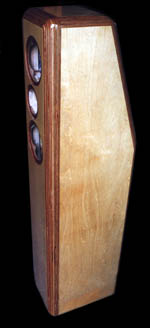
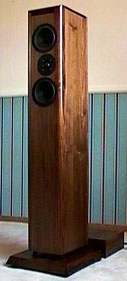
Design principles The design follows the following three principles:
1. It is higher than the general efficiency and has a natural and realistic sound, a wide sound field and a neutral tone.
2. The design is as simple as possible. The design of the crossover is simple enough to fine-tune the sound by replacing different resistors, capacitors, coils, etc. and changing the filling of the damping material in the maze.
3. Relatively easy woodworking process, the golden ratio is used in many places in the design to reduce the frequency response fluctuations caused by the labyrinth design and panel diffraction.
The unit selection guides the design in the spirit of "conciseness" at the beginning, so work harder in the unit selection to avoid using units that require special frequency equalization circuits to correct the frequency response.
VIFA's P13WH-00-08 is a 5.5-inch mid-woofer with a polypropylene diaphragm and a magnetic pole with an air outlet. It does not have a typical 7 or 8-inch polypropylene speaker and has a slightly muddy mid-frequency (the reason is that the diameter is small and the diaphragm It is harder than a large caliber), and the more striking is its frequency response. The straight intermediate frequency response is up to 5KHZ and then drops smoothly at 12 db / Oct, so a simple divider can be used and the frequency equalization circuit can be abandoned. In fact, the human ear is very sensitive to the crucial intermediate frequency. The designer found that traditional speakers have many peaks and valleys at the intermediate frequency. HIFI speakers usually use frequency equalization circuits to correct the intermediate frequency response. Individual speakers of the circuit (the author points out that the only other option is Focal's 6V415, but it has a small peak at 4.5kHz). However, the disadvantage of VIFA's P13WH-00-08 is that the sense of low frequency is slightly smaller and the sinking depth is insufficient, so the designer uses a pair of P13WH-00-08 to install in a 6-foot transmission line, which can extend the low frequency F3 to 60HZ (as Contrast: Installed in the QB3 response inverting box, F3 is at 80HZ and drops at 24db / oct), using a pair of units also improves the acoustic radiation impedance, so the sensitivity is increased by nearly 6db. (Rising from 88db / W / M to an average of 92db / W / M), the power withstand capacity has also doubled, the benefits are self-evident, the disadvantage is the use of one more unit, the cost increases, and due to the dumbbell arrangement The minimum listening distance is 2 meters.
The following is the appearance and frequency response diagram of VIFA's P13WH-00-08
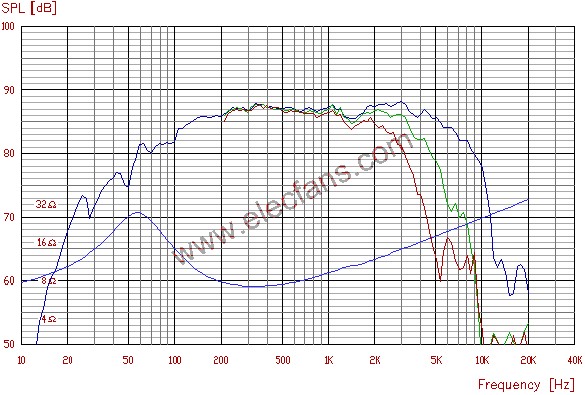
Some people think that the F3 of this box is too high. In fact, the design of this box is to have a very natural sound, the middle frequency and high frequency are absolutely first-class, and the attenuation below F3 is slower. In the mid-range HI-END speakers from $ 1000 to $ 5000, the usual compromise is to meet the needs of some enthusiasts: give up the extremely clear mid-frequency, and then produce a stronger low-frequency. Therefore, if a 6.5 "or 8" speaker is used, the low frequency can be improved, but the frequency equalization circuit must also be used to correct its fluctuating intermediate frequency response-this does not significantly improve the intermediate frequency sound quality.
The choice of tweeter is relatively easy, not as poor as a good mid-woofer. Because of the development of materials science, acoustic holography technology, and computer simulation technology, soft dome tweeters have taken a big step forward. For example, Scan-Speak D2905 / 9500 and D2905 / 9700 have surpassed the best metal dome tweeters. The Scan-Speak D2905 series has a total of 9000, 9300, 9500, 9700, 9900, etc. A total of 5 models, the later models are higher in price, the designer used 9000 at the time of initial design, and after testing and improvement, the designer believes that Ariel is the most suitable Use 9500 (use 9000, 9300 performance is slightly reduced, 9700 and 9900 are not recommended-although more expensive, the frequency divider is designed for 9500, unless you have sophisticated measurement tools to redesign the frequency divider ), Which is an improved version of 9300, uses magnetic fluid damping and cooling, and uses the same resonance-free diaphragm back cavity as the highest model 9900.
The following figure is the shape and frequency response diagram of 9500

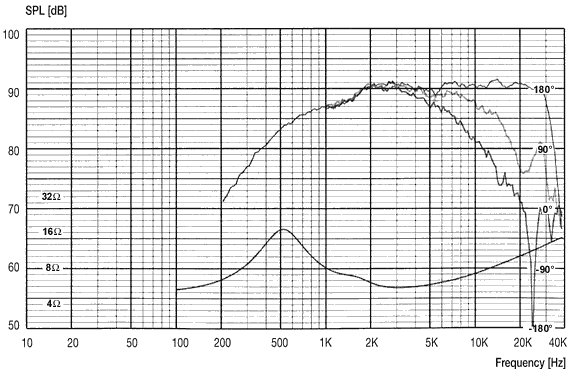
Objectively speaking, VIFA P13WH-00-08 and Scan-Speak D2905 / 9500 are one of the most natural and flat frequency speakers in the world. The frequency response, group delay graph, and waterfall graph are also exceptional. [page]
The initial version of the development process (MK1) is relatively simple. The three speakers are installed in the same acoustic cavity-they are not separated, and the transmission line folded into two sections is used. The outlet is above the rear of the speaker. This version of the bass is lacking. But the midrange and treble are quite satisfactory. To this end, the designer and friends discussed and improved, trying to place the outlet a few inches high from the floor (fold the transmission line into three sections, the outlet is below), and the bass came out, they think it is the floor that reflects the low frequency , Improve low-frequency efficiency, power tolerance and reduce distortion, and the acoustic response is more closely related to the room. Later, a new type of transmission line designed by Randy was adopted. Its characteristics are: 1. A mixture of 1/4 wavelength resonant (TL) and labyrinth design. The total length is 1 / 3-1 / 2 points after the labyrinth. 2. Move the position of the speaker unit from the starting point of the transmission line to 1/5 of the total length, and fill the damping sound-absorbing objects from 0 to 1/5, and fill some thin damping objects at the remaining appropriate positions. This produces MK2.
MK2 is a major turning point in Ariel's history. This version proposes the concept of using mixed 1/4 wavelength resonance (TL) and labyrinth. The traditional 1/4 wavelength resonance is difficult to handle the 80-200Hz frequency band. There will be some in this band Resonance produces peaks and valleys, and filling too much damper will cause dynamic compression-this is a difficult problem to deal with. MK2 solves the problem better. The two woofers have relatively separated cavities. At first, they were 1/4 wavelength resonant. The inclined and twisted partitions behind the speaker unit reduced the reflection effect of the cabinet. The labyrinth parts are merged again.
Everyone complains that it is difficult to process the positioning of the 15-degree baffle, so MK3 improved the baffle behind the speaker and slightly corrected the maze. The result is that the frequency response of the upper and lower frequency parts is smooth.
According to the proposal of Ariel club members, each unit of MK4 uses a completely independent pipeline (MK3 is merged in the maze part), which reduces the mutual influence between the two units and the delay interference caused by the different distances. Moreover, the cross section of the quarter-wavelength resonance tube before the labyrinth part is gradually reduced, which significantly improves the acoustic staining of the mid-low frequency part of 100-500 Hz.
There is a problem that the bass will be too much in a room less than 8 feet high. After testing, it is found that the speaker can be brought closer to the ground to adjust the size of the outlet to improve this problem.
Therefore, three slightly different versions of MK5B, MK5R, and MK5S are derived. The outlet of MK5B is at the bottom. When adjusting the size, the speaker should be moved up and down. The outlet of MK5R is at the back. You can adjust the size of the outlet with another wooden plate Beside, it is distributed. In theory, there is no difference between the three versions. However, due to the different exit positions, the overall characteristics are slightly different after synthesis with the acoustic characteristics of the room.
In the newly released MK6, different wood materials are used for the rear panel, and items such as iron sand and lead bullets are allowed to be filled, which further reduces the resonance of the cabinet. At the same time, the labyrinth exit has been improved, making it easy to adjust the exit size.
Box design and production The structure of this box is different from that of the horn. The cross-section changes in the transmission line are more messy-the advantage is that the air flow speed in the transmission line can be reduced, and the smoother the transition of the ordinary horn section, the better.
The installation center of the tweeter is not at the vertical center line of the panel, but at the golden section point. The purpose is to reduce the upper mid-band fluctuations and staining caused by the diffraction of the left and right corners of the panel (the sharply changed edges of the left and right corners of the panel are diffracted under the action of sound waves , This diffraction interferes with the sound waves emitted by the horn and acts on the diaphragm of the horn, causing fluctuations and staining of the intermediate frequency response). Similarly, the installation axis of the woofer also deviates from the vertical centerline. It should be noted that the arrangement of the left and right channel speaker speakers is mirrored. At the same time, the transition between the front panel and the side panel should use an arc transition with a radius of 3/4 inch.
The front panel is bonded with two 3 / 4-inch (19mm) premium MDFs, and the outer panel uses 3 / 4-inch premium MDF (the thickness of the rear panel can be increased, for example, 1 inch or thicker). The backboard uses multi-layer plywood, which is 3 to 4 times stronger than MDF. When there is no plate of suitable thickness, the inside dimensions of the box should be the same. When there is no MDF or multi-layer plywood, the inner plate should use a harder plate, and the outer plate should use a relatively soft plate. The inner panel and the outer panel are best fixed by means of tenoning and adhesive bonding. It is not recommended to fix them with screws. Accurate woodworking techniques should be used to ensure the fastness of fixation, that is, they should be embedded before applying glue to see if they have Very firm.
The outer diameter of the mid-woofer is 5.53 (5 17/32) inches, the edge depth is 3/16 inches, the opening size is 4.56 (4 9/16) inches, the outer diameter of the tweeter is 4.125 inches, and the edge depth is 0.156 (5 / 32) inches, the opening size is 3.25 inches. The angle of the mounting screws is preferably 45, 135, 225, 315 degrees. It is not recommended to use wood screws for installation, because wood screws cannot provide uniform torque and cannot undergo multiple disassembly. ,installation. T-nuts should be used to fix the other side of the hole, and then use hexagon socket bolts to fix the horn.
During installation, the gasket material should be used to ensure that there is no air leakage, and the installation cavity of the tweeter is isolated from the cavity of the mid-bass horn, so its leads should be sealed with glass glue or the like. The panels of the two units must not protrude from the cabinet panel, otherwise it will cause serious measurable distortion and frequency response fluctuations.


Damping, sound-absorbing material placement The simple way to test the panel damping is to put a section of dynamic music such as chorus and orchestral music, stick your ears to the front and rear sides of the speaker near the speaker, and listen for bad vibration and unpleasant hum Buzz. The partitions inside Ariel have played a very good role in strengthening the cabinet. If your carpentry level is good, the vibration is very small, otherwise you should review your carpentry level and take corresponding measures to improve it.
Then put some thin sponge, wool and other materials in the back of the mid-bass horn (do not block the air outlet at the rear of the horn). Then stick a 1/2 inch thick wool blanket on the surface of the partition like the structure diagram of the speaker (note that there is no damping material on the surface of the left panel in the front view, in fact, it should also be attached). In the labyrinth pipe, some sound-absorbing materials can be placed loosely according to the results of the audition. [page]
The design and improvement of the frequency divider and the audition are as expected, because the characteristics of the unit itself are very smooth. At the beginning, Ariel used a really simple design, using a 2UF capacitor in series with the tweeter, and then using a 16 OHM resistor in parallel with the tweeter to reduce the impact caused by the change in impedance of the unit. Theoretically, it is perfect, and the test results are also very good it is good. But it doesn't sound very good, just like normal speakers, it's a bit unnatural and produces more high-pitched sounds. The designer adjusted the values ​​of C and R many times, but there is not much improvement, so it is not always the best to be popular. Later I found the source of the problem-the maximum linear displacement of the tweeter is very small, the first-order frequency divider is too slow to decay in the frequency band below the frequency division point, causing excessive power to enter the tweeter unit, resulting in a larger diaphragm The displacement exceeds the linear displacement. Produced large distortion. Therefore, the 12db / Oct two-stage high-pass crossover is used instead, and the treble is connected. (In other words, the treble of the first-order crossover originally designed should be reversed to align the phase. Designers prefer to use filters with different slopes so that the treble can be directly connected to achieve better group delay characteristics).
The redesigned Qualcomm section is as follows:
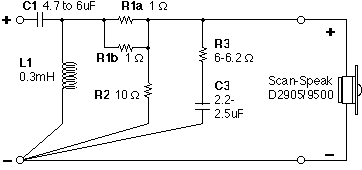
C1 and L1 form a low-Q two-stage filter, R2 is a damping resistor, and R3 and C3 form inductive compensation.
The low-pass filter also needs to be modified. Although the frequency response of the mid-bass unit is very smooth, relatively speaking, the intermediate frequency is still a bit prominent, so the designer designed the impedance compensation circuit and tried to change the value of the component to get good results. The design is as follows:
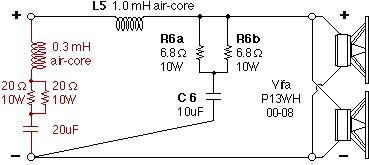
The LCR circuit on the left is used to absorb the impedance peak of 30 OHM near 2KHZ. After use, the impedance peak is limited to 8 OHM, the impedance between 10HZ-100KHZ is between 3.5 OHM and 8 OHM, and the impedance between 200HZ and 800HZ is 4.5 OHM. , So it should be connected to the 4 OHM port when using the amplifier. The frequency response after using the new crossover is as follows:

(Measurement distance 2 meters, 0 axis), it can be found that the 100HZ-10KHZ is very smooth, with a drop of about 2 db, and reaches the lowest point around the 3.8KHZ crossover point (a bit similar to the equal loudness curve of the human ear).
Qualcomm's capacitance can be fine-tuned, which affects the distance of the sound field. It cares about personal preferences and actual environment, positioning, etc. The designer recommends that if the sound image is too far, you can change C1 to 6UF. And, it remains at 4.7UF. It is also recommended that C1 do not use polypropylene capacitors such as SOLEN. It is strongly recommended to use silver oil capacitors of North Creek, Hovland, or VTV of Teflon material. Although it is expensive, this is the most important component of this speaker, and its role is very huge-its importance is even more important than CD players and preamps! ! ! The capacitors should be matched within 1%. And pay attention to the direction of the capacitor (though the film capacitor has no polarity, there are still certain differences in the positive and negative directions). It is also recommended to try to use a 4.7UF polypropylene capacitor in parallel with a 0.47UF Teflon capacitor.
In addition to the C1 capacitor can be fine-tuned, the high-frequency level can also be adjusted slightly by changing the values ​​of R1 and R2. (Note: R1 is made up of R1A and R1B in parallel in the drawing) For example, removing R1, R2 and changing to 16 OHM can get more treble. R1 is 1 OHM and R2 is 8 OHM. R1 is 0.5 OHM and R2 is 10 OHM. The slight change in the resistance value causes a very large change in timbre, so the increment of each change should be small, and the value should be determined by listening to a large number of types of music. It took Lynn Olsen 3 months to design, modify and debug the crossover, and obtained 15 slightly different versions using MLSSA, LMS and other testing equipment.
It is recommended to play pink noise to test the cabinet damping and crossover when there is no measuring instrument, so that it is more sensitive to the sound staining of a certain frequency band, but the valley point of the spectrum cannot be heard (unless the valley point is very deep). Conditional available MLSSA, FFT, LMS and other tests and improvements. Please refer to the published MLSSA test results and near field test results.
MLSSA test results

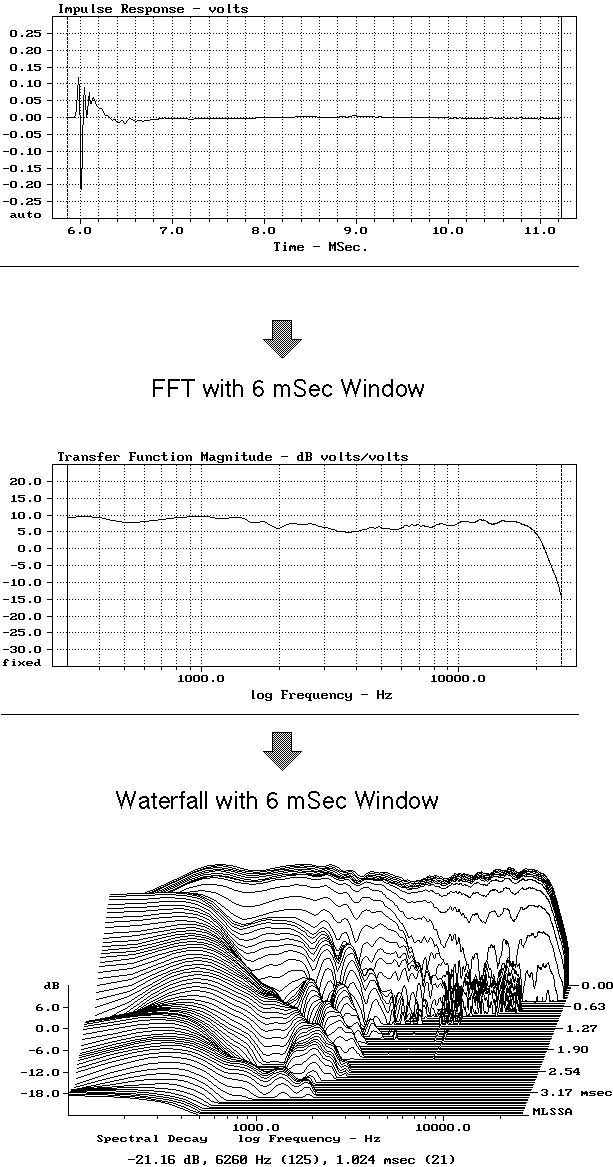
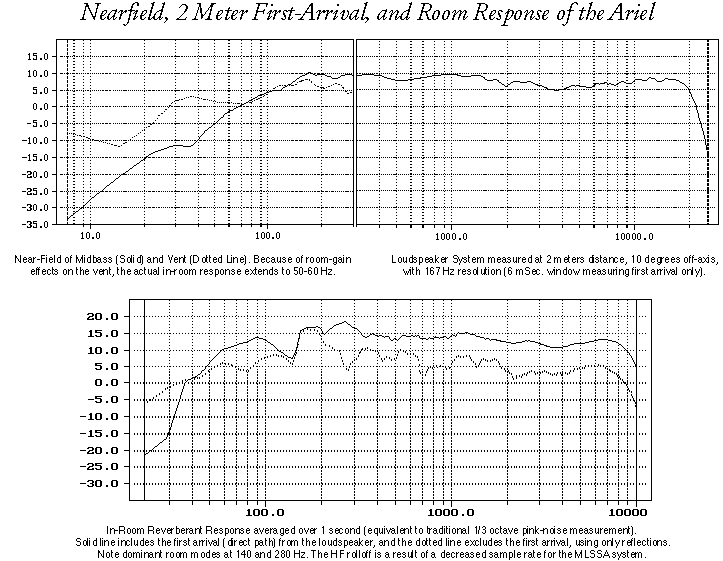
Near-field test results (it can be seen in the room that F3 has expanded downwards)
The frequency divider should be installed in a separate wooden box and isolate the vibration of the capacitor. It should be at least 12 inches away from the large iron / steel object. The coils should be separated by more than 6-8 inches and placed perpendicular to each other. , And use two-line crossover.
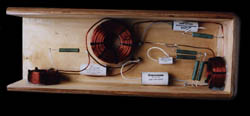
It is recommended to rotate Ariel to a certain angle (the angle between the axis of the speaker 0 and the connection between the two speakers is 50-55 degrees, that is, the projection intersection point of the speaker is 1 to 2 feet in front of the listening position). For the sound image and sound field, Ariel requires a minimum of 1.5 meters of vacant space, try not to place other things around the box, and use damping and sound absorbing materials as little as possible in the room. Properly adjust the angle of inward rotation, the distance between the speakers, the distance from the back wall and the listening position to prevent the void in the middle of the sound field. Ariel provides a fan-shaped sound field and the left and right sides exceed the range of the speaker by 2-3 feet. 5-10 feet, the sound image is also very stable.
Efficiency and amplifier requirements
The average efficiency of Ariel is 92db / W / M, which is much higher than the average small monitor speakers. In fact, the 8W triode tube amplifier can work very well, and the 20-30W tube amplifier can meet all needs. It is recommended to use small and medium power push-pull amplifiers with small feedback coefficients to drive.
Ip65 Interactive Advertising Player with IP65 front water proof,
with personality, fashion appearance, definitely display
Effect, operating easily.flexible place way, comparison with 10 points Touchwo exclusive touchTechnology, breakthrough the traditional advertising`s space limit of display & play only, challenge the
Simple single touch application. Meet all of your requirements for indoor & outdoor information.
IP65 Interactive Advertising Player
Touch Screen Display,Digital Advertising Player,Indoor Digital Advertising Display,Ip65 Interactive Advertising Player
Guangzhou TouchWo Electronics Co.,Ltd. , https://www.touchaio.com